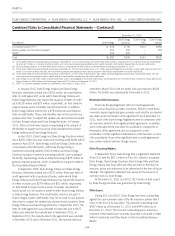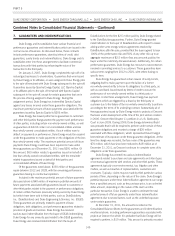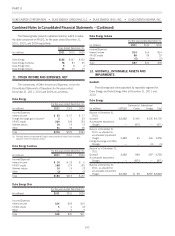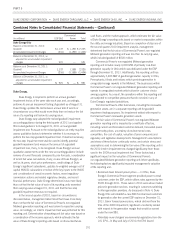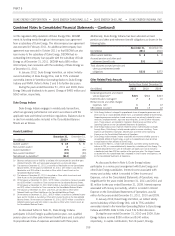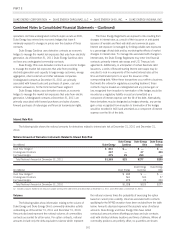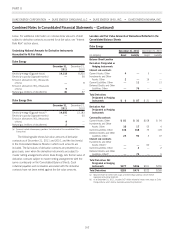Duke Energy 2011 Annual Report Download - page 172
Download and view the complete annual report
Please find page 172 of the 2011 Duke Energy annual report below. You can navigate through the pages in the report by either clicking on the pages listed below, or by using the keyword search tool below to find specific information within the annual report.
PART II
DUKE ENERGY CORPORATION •DUKE ENERGY CAROLINAS, LLC •DUKE ENERGY OHIO, INC. •DUKE ENERGY INDIANA, INC.
Combined Notes to Consolidated Financial Statements – (Continued)
proposed rules associated with the regulation of CCRs to
address risks from the disposal of CCRs (e.g., ash ponds) and
to limit the interstate transport of emissions of NOxand SO2.
These proposed regulations, along with other pending EPA
regulations, could result in significant expenditures for coal
fired generation plants, and could result in the early retirement
of certain generation assets, which do not currently have
control equipment for NOxand SO2, as soon as 2014.
•Customer switching — ESP customers have increasingly
selected alternative generation service providers, as allowed by
Ohio legislation, which further erodes margins on sales. In the
second quarter of 2010, Duke Energy Ohio’s residential class
became the target of an intense marketing campaign offering
significant discounts to residential customers that switch to
alternate power suppliers. Customer switching levels were at
approximately 55% at June 30, 2010 compared to
approximately 29% in the third quarter of 2009.
As a result of the factors above, a non-cash goodwill impairment
charge of $500 million was recorded during the second quarter of
2010. This impairment charge represented the entire remaining
goodwill balance for Commercial Power’s non-regulated Midwest
generation reporting unit. In addition to the goodwill impairment
charge, and as a result of factors similar to those described above,
Commercial Power recorded $160 million of pre-tax impairment
charges related to certain generating assets and emission allowances
primarily associated with these generation assets in the Midwest to
write-down the value of these assets to their estimated fair value. The
generation assets that were subject to this impairment charge were
those coal-fired generating assets that do not have certain
environmental emissions control equipment, causing these
generation assets to be heavily impacted by the EPA’s proposed rules
on emissions of NOxand SO2. These impairment charges are
recorded in Goodwill and Other Impairment Charges on Duke
Energy’s Consolidated Statement of Operations.
During 2009, in connection with the annual goodwill
impairment test, Duke Energy recorded an approximate $371 million
impairment charge to write-down the carrying value of Commercial
Power’s non-regulated Midwest generation reporting unit to its
implied fair value. Additionally, in 2009 and as a result of factors
similar to those described above, Commercial Power recorded $42
million of pre-tax impairment charges related to certain generating
assets in the Midwest to write-down the value of these assets to their
estimated fair value. These impairment charges are recorded in
Goodwill and Other Impairment Charges on Duke Energy’s
Consolidated Statement of Operations. As management is not aware
of any recent market transactions for comparable assets with
sufficient transparency to develop a market approach fair value, Duke
Energy relied heavily on the income approach to estimate the fair
value of the impaired assets.
The fair value of Commercial Power’s non-regulated Midwest
generation reporting unit in 2009 was impacted by a multitude of
factors, including current and forecasted customer demand, current
and forecasted power and commodity prices, impact of the economy
on discount rates, valuation of peer companies, competition, and
regulatory and legislative developments. These factors had a
significant impact on the risk-adjusted discount rate and other inputs
used to value the non-regulated Midwest generation reporting unit.
More specifically, as of August 31, 2009, the following factors
significantly impacted management’s valuation of the reporting unit
that consequently resulted in an approximate $371 million non-cash
goodwill impairment charge during the third quarter of 2009:
•Decline in load (electricity demand) forecast —Asaresultof
lower demand due to the continuing economic recession,
forecasts evolved throughout 2009 that indicate that lower
demand levels may persist longer than previously anticipated.
The potential for prolonged suppressed sales growth, lower
sales volume forecasts and greater uncertainty with respect to
sales volume forecasts had a significant impact to the
valuation of this reporting unit.
•Depressed market power prices — Low natural gas and coal
prices put downward pressure on market prices for power. As
the economic recession continued throughout 2009, demand
for power remained low and market prices were at lower levels
than previously forecasted. In Ohio in 2009, Duke Energy
provides power to retail customers under an ESP, which
utilized rates approved by the PUCO through 2011. These
rates were above market prices for generation services. The
low levels of market prices impacted price forecasts and
placed uncertainty over the pricing of power after the
expiration of the ESP at the end of 2011. Additionally,
customers began to select alternative energy generation service
providers, as allowed by Ohio legislation, which further eroded
margins on sales.
•Carbon legislation/regulation developments — On June 26,
2009, the U.S. House of Representatives passed The
American Clean Energy and Security Act of 2009 (ACES) to
encourage the development of clean energy sources and
reduce greenhouse gas emissions. The ACES would create an
economy-wide cap and trade program for large sources of
greenhouse gas emissions. In September 2009, the U.S.
Senate made significant progress toward their own version of
climate legislation and, also in 2009, the EPA began actions
that could lead to its regulation of greenhouse gas emissions
absent carbon legislation. Climate legislation has the potential
to significantly increase the costs of coal and other carbon-
intensive electricity generation throughout the U.S., which
could impact the value of the coal fired generating plants,
particularly in non-regulated environments.
The fair values of Commercial Power’s non-regulated Midwest
generation reporting unit and generating assets for which
impairments were recorded were determined using significant
152




